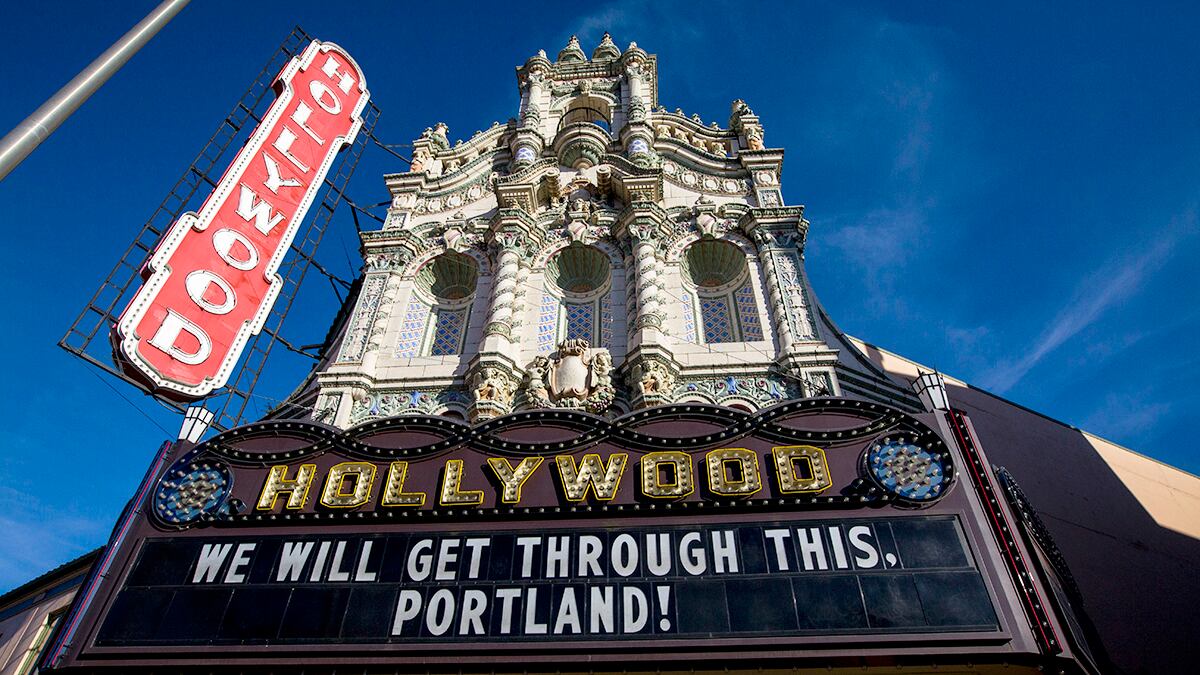On June 18, for the first time in Hollywood Theatre's 94 years of service, the iconic motion picture palace opened its main auditorium for private screenings. Although the initial invitation to reserve the 384-seat space only went out to Hollywood's members, and the number of people who can attend any single booking is capped at 10, the preliminary run of scheduled rental dates sold out in less than an hour. As a well-staffed nonprofit boasting a robust and devoted following, the Hollywood is perhaps uniquely positioned to adapt during unprecedented circumstances. But this new foray into small-group, big-screen rentals represents its biggest break yet with tradition.
"It's sort of funny," Hollywood executive director Doug Whyte admits. "Even though we're closed, we're busier than ever."
As should be expected from a theater whose popcorn to go options include a Champagne Package, exclusive access to the Hollywood's gorgeous interior and state-of-the-art A/V system don't come cheaply. Digital screenings cost $400 to the general public and $300 for members. Anyone looking to watch a 35 mm print from its daunting basement archive will need to pay a bit more ($600, $450), and a 70 mm showing is even pricier ($950, $715).
And here's something you could never get at a Regal: Silent film enthusiasts can request the house pipe organist to provide a live score ($1,200, $900).
"We're putting our toe in the water to see how safe things feel and whether people keep their distance," says Whyte. "But this is actually pretty cool. Cinephiles could come to a private screening of Dunkirk or 2001 in 70 mm. Two families already commingling might bring their kids to watch Frozen. We've never done something like this before, but people will be able to rent the place for at least the next three weeks while we wait to see about Phase 2. My guess is, we might continue a bit longer than that."
For lower prices, up to five guests could soon choose instead to reserve the video rental emporium/memorabilia museum Movie Madness Miniplex: an 18-seat screening room featuring Dolby Atmos sound, laser projection and its signature Cult Classic Pale Ale from Ex Novo. The Hollywood's sister nonprofit relaunched shortly before the COVID-19-driven home entertainment boom and successfully catered to the quarantine crowd through contactless curbside pickups. The virus did interfere with the scheduled debut of Movie Madness University's in-store lectures, but the move online allowed more than 100 curious students access to virtually audit lectures by the likes of Hollywood head programmer Dan Halsted, community programmer Anthony Hudson and local author Shawn Levy.
Not all outposts in the Hollywood empire have proven so malleable, of course. Oregon State Parks and Recreation, the theater's partner in a summertime series of classic film screenings at campgrounds and day-use areas, called for the events to be canceled this year. And the theater's free microcinema inside Portland International Airport will remain shuttered indefinitely.
On the other hand, the nonprofit's 2019 experiment with drive-in showings at the Expo Center seems especially prescient. The Hollywood hopes to expand that program and add occasional car-friendly pop-up presentations, like the upcoming drive-in it's arranging for Port of Portland employees in the airport parking garage.
"It'll just be a regular drive-in," Whyte says. "Great films, a big screen, nice sound system, and an FM transmitter you can tune in on your car."
A return to the theater's original trade remains the overriding goal, but while a successful transition to Phase 2 could ease restrictions on venues as early as July 10, difficult questions surround both supply and demand. With few notable exceptions (Tenet, Mulan), the release of nearly every major motion picture has been postponed until fall or 2021. Moreover, since the main auditorium's architectural constraints permit just about 65 patrons under physical distancing guidelines, organizers cannot yet gauge the general public's willingness to embrace group activities, nor the long-term economic viability of such small crowds, though Whyte remains hopeful.
"Whenever it feels safe to go out again," he says, "people will be so tired of sitting at home and streaming that they'll cherish even more the idea of coming to a beautiful building, having some beer and some popcorn, and watching a 70 mm print with a bunch of people who'll talk about it afterwards."
